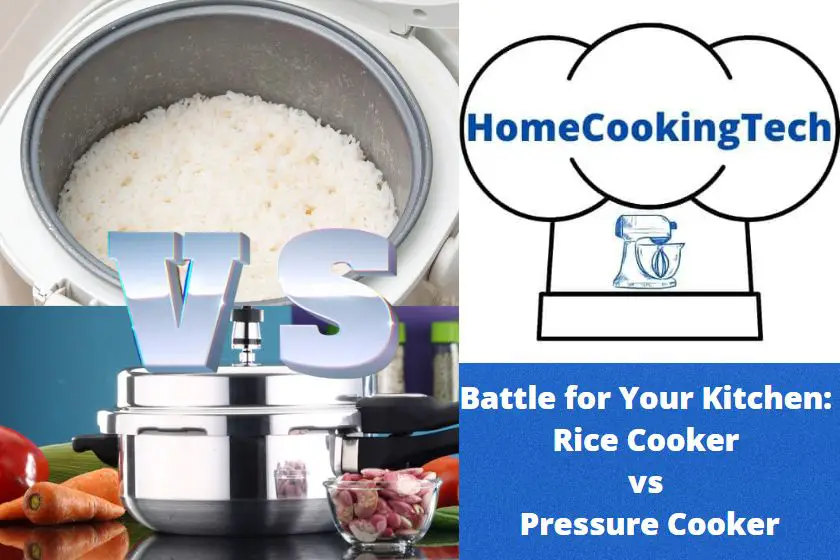The kitchen is one of the most critical places in the home, and having the right appliances can make all the difference. Whether you’re a home chef or simply cooking, investing in the right tools can save you time and energy.
Recently, rice cookers and pressure cookers have emerged as the best-known kitchen appliances. This blog post will explore the differences between the two and help you decide which is best for your kitchen.
I will discuss topics such as convenience, time, and cost. Ultimately, I will provide a comprehensive comparison of the rice and pressure cooker to help you get the most out of your kitchen.
Time efficiency
One of the main advantages of a pressure cooker compared to a rice cooker is time efficiency. Pressure cookers cook food much faster than rice cookers, often reducing cook times by as much as 70 percent.
This can be a huge benefit for busy families looking for ways to get meals on the table faster. In addition, pressure cookers can be used to make dishes that would otherwise take much longer to prepare, such as stews and soups.
Types of food cooked
Rice and pressure cookers are two of the most commonly used kitchen appliances. Both are designed to cook food quickly using moist heat, but the way they do it is pretty different. Rice cookers use a slower, more gradual process, which produces fluffy and evenly cooked rice.
On the other hand, pressure cookers use pressure to force steam and heat into the pot, resulting in food that is cooked faster and more thoroughly.
The types of food you can cook with either appliance also vary. Rice cookers are best for grains and legumes, while pressure cookers are better for stews, roasts, and other dishes that require tenderizing.
Size and Capacity
Regarding size and capacity, the two types of cookers differ significantly. Rice cookers typically come in smaller sizes and are designed for cooking smaller amounts of food. They usually can cook between 4 and 8 cups of uncooked rice, which equates to about 2-4 servings.
Pressure cookers, on the other hand, come in larger sizes and are designed for cooking more significant amounts of food. Most pressure cookers can accommodate up to 8 quarts, enough to feed a family of four or more.
Portability
When it comes to portability, pressure cookers shine.
Most pressure cookers come with a handle and a locking lid, so they are much easier to tote around than a traditional rice cooker. Not only that, they are smaller in size and take up less space in your kitchen, making them a much more convenient option if you lack counter or storage space.
If you plan on taking your pressure cooker on a camping trip or to a friend’s house, you can also purchase a unique carrying bag for easy and safe transport.
Cost
When it comes to cost, there are differences between a rice cooker and a pressure cooker. A rice cooker is typically more affordable and can be found for under $50.
Pressure cookers, on the other hand, can cost anywhere from $100 to over $200, depending on the brand, size, and features.
Generally speaking, pressure cookers are more expensive than rice cookers. Still, they can be worthwhile if you plan to use them regularly.
Versatility
Consider a pressure cooker if you’re looking for a kitchen appliance to do it all. Pressure cookers are more versatile than rice cookers because they can be used for more than just cooking rice. You can cook an entire meal in one pot with a pressure cooker.
They also come in many different settings, giving you more control over the cooking process.
These appliances can also be used for steaming vegetables, making soups and stews, and even baking cakes.
Quality of food cooked
Regarding the quality of the food cooked with a rice or pressure cooker, both appliance types can produce delicious, well-cooked meals. However, the pressure cooker has an edge in this department.
It can quickly and easily get food cooked to perfection, with less risk of over or undercooking. Pressure cookers also lock in flavor and nutrients, making the food tastes richer and more flavorful.
On the other hand, rice cookers are more suitable for preparing rice and other grains, where precise cooking times are essential.
Is Preheating Necessary for Rice Cookers as Well as Pressure Cookers?
The surprising truth about pressure cooker preheating is that unlike traditional cooking methods, it is not necessary for rice cookers as well as pressure cookers. These modern appliances are designed to reach and maintain high temperatures quickly, eliminating the need for preheating. Simply add your ingredients, set the timer, and enjoy a perfectly cooked meal in no time.
Ease of use
While both appliances are reasonably easy to use, a rice cooker is the simpler of the two. When it comes to ease of use, it’s hard to beat a rice cooker. All you need to do is measure out your ingredients, add them to the pot, turn it on, and wait for the cooked rice to be ready.
On the other hand, pressure cookers require you to monitor the cooking process carefully and make adjustments when needed. Pressure cookers also need more time to come under pressure, and they can be dangerous if misused.
In conclusion, rice cookers and pressure cookers are excellent kitchen appliances that can save time and effort when preparing meals.
Rice cookers are best for cooking rice and grains, while pressure cookers are better for cooking more challenging, denser foods. Depending on your needs, either may be the best choice.
However, a combination pressure and rice cooker may be the best choice if you’re looking for a versatile appliance that can do both.




















